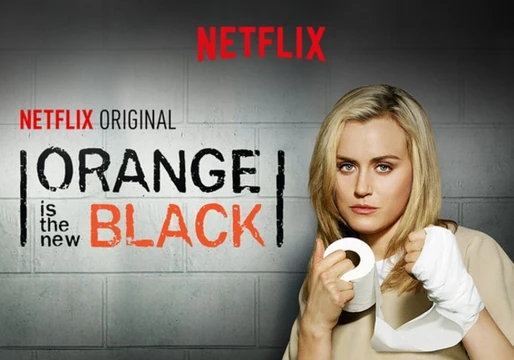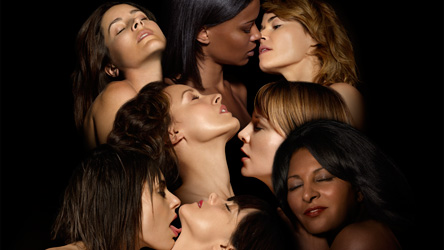MEST4 Summer project
Chosen text of investigation: Orange Is The New Black
(Netflix original series)
Media Representations
 The focus of my critical investigation into the Netflix exclusive: ‘Orange Is The New Black’ will be warranted actuely, however not exclusively, to women. Although the comedy-drama series is most recognisably rewarded for its humanistic depiction of prisoners (as praised by Seth Abramson of The Washington Post), I was personally drawn to investigate gender and sexuality as OITNB employs a predominantly female cast. Now hold your horses, yes we have shows such as Girlfriends - undoubtedly a great show, acknowledgedly a millennial breakthrough in the respects of it not just having a cast preponderated by women, but more so because this was a show, for the first time ever on mainstream television, dedicated to black women. And of course we have ‘Sex and the City’, ‘Charlie’s Angels’, ‘Naked News’, ‘The ‘L’ word’, ‘American’s Next Top Model’, ‘A Model’s Life’.
The focus of my critical investigation into the Netflix exclusive: ‘Orange Is The New Black’ will be warranted actuely, however not exclusively, to women. Although the comedy-drama series is most recognisably rewarded for its humanistic depiction of prisoners (as praised by Seth Abramson of The Washington Post), I was personally drawn to investigate gender and sexuality as OITNB employs a predominantly female cast. Now hold your horses, yes we have shows such as Girlfriends - undoubtedly a great show, acknowledgedly a millennial breakthrough in the respects of it not just having a cast preponderated by women, but more so because this was a show, for the first time ever on mainstream television, dedicated to black women. And of course we have ‘Sex and the City’, ‘Charlie’s Angels’, ‘Naked News’, ‘The ‘L’ word’, ‘American’s Next Top Model’, ‘A Model’s Life’.  However, the common denominator of all of these shows is very obvious, as much as ever are women sexualised in these texts and consistently used for the voyeuristic gratification of audiences. And this is what fuels the basis of my investigation into OITNB, because what Jenji Kohan has acclaimed to craft here is by no means a story of young women aspiring to capitalise off and commercialise their (probably fake) tits and nips, nor is it a series of provocatively dressed women supposedly cracking cases by the orders of a creepy man over a speakerphone. Arguably, OITNB differs by dimensionalising the women who are granted complex traits linked to narratives of their conviction which convince an audience to sympathise for them ('Orange Is the New Black' offers complex look at LGBT women). This raises accusations of reverse-sexism as the actions of men in the series are represented in a higher magnitude of negligence than even those of the female felons. {examples: drugs, sex, violence etc. - compared to men’s stories - not as severe from a sexually impartial perspective} Audiences are encouraged indubitably to be sympathetic for the women in the show, by the manipulation of representations which I’d say are fair and accurate to the extent of the characters reflecting valid social realism, but not to the extent that no male characters are constructed to be favourable by the audience. {Even the protagonist’s brother, who is in fact dominated by his female counterpart in the marriage}
However, the common denominator of all of these shows is very obvious, as much as ever are women sexualised in these texts and consistently used for the voyeuristic gratification of audiences. And this is what fuels the basis of my investigation into OITNB, because what Jenji Kohan has acclaimed to craft here is by no means a story of young women aspiring to capitalise off and commercialise their (probably fake) tits and nips, nor is it a series of provocatively dressed women supposedly cracking cases by the orders of a creepy man over a speakerphone. Arguably, OITNB differs by dimensionalising the women who are granted complex traits linked to narratives of their conviction which convince an audience to sympathise for them ('Orange Is the New Black' offers complex look at LGBT women). This raises accusations of reverse-sexism as the actions of men in the series are represented in a higher magnitude of negligence than even those of the female felons. {examples: drugs, sex, violence etc. - compared to men’s stories - not as severe from a sexually impartial perspective} Audiences are encouraged indubitably to be sympathetic for the women in the show, by the manipulation of representations which I’d say are fair and accurate to the extent of the characters reflecting valid social realism, but not to the extent that no male characters are constructed to be favourable by the audience. {Even the protagonist’s brother, who is in fact dominated by his female counterpart in the marriage} Media Languages and Forms
A predominant and rather broad connotation of the text revolves around the title: ‘Orange Is The New Black’, which plays on the 80s phrase “- is the new black” used to describe a trend or change of some sort which can be deemed popular, cool or fashionable. However, in the premise of prison life, where ‘orange’ is the stereotypical colour for prison garments, Piper Chapman (the protagonist) faces an ironic alteration in her living as she is to transition from her life as an attractive, white, affluent New Yorker to the polar opposite of fashionable, as a prisoner in a New York federal penitentiary where she is forced to embrace the realities imposed upon her - survive in prison.
An interesting manipulation of the cinematography and mise-en-scene throughout the show is demonstrated as the audience perceives everything in Litchfield prison through the eyes of Piper. Due to this, as Piper initially enters the federal institute, close-up panning shots depict the ruthlessness of the prisoners around her upon their introduction - complemented with scornful facial expressions and obscene language. However this begins to subside correspondingly to Piper’s increasing courage and resistance to the harshness surrounding her in prison, after which the audience should witness a change in the patterns of cinematography and mise-en-scene to be in favour of the prisoners in order to evoke sympathy rather than fear.
Uzo Aduba on OITNB, Charleston, and the Confederate Flag - A star of the show sheds light on key socio-political issues concerning themes covered in OITNB. This is inclusive of the controversial Confederate flag.
Narrative
OITNB, being based on the memoirs of writer and ex-convict Piper Kerman, present the accounts of the protagonist’s trials and tribulations through her own experiences. Within the expository 4 hours of the show, the audience is familiarised with the conviction stories of characters including of course - Piper, but also Red, the cafeteria mogul of the prison, for whom the audience is placed on the brink of a multitude of opinions instead of simply disliking her due to her unfavourable representation towards the protagonist. The reason for this is because of the narrative’s craftation into exhibiting retrospective scenes of the characters’ pasts preceding their conviction. These flashbacks are applaudable also for their diligent integration into the script as the dialogue featured in the scenes are synchronised to
the present experiences of the character in question - leaving the audience gasping in awe and questionability regarding the seamlessness of the narrative. The delineation of characters is also demonstrated witful as the audience is constantly barged into the disposition of accepting fallacies about characters who are temporarily vilified, but may even be righteous and likeable. Warranting this, it is important to acknowledge the producer’s representation of moral conflicts such as rape, drug abuse and most interestingly: prejudice against minority groups of race, gender, body types and sexuality.
Orange Is the New Black's Irresponsible Portrayal of Men - OITNB absolutely vilifies men in the entirety of the show, to the extent that it becomes an unrealistic representation of the social system in nations such as the UK and America. Because of this, the show arguably loses credibility in the sense of it striving to encourage a social movement to raise awareness of prejudice faced by minority groups - and as a consequence, the arguments for the liberation of women and other oppressed groups lose validity
The comedy drama is consistent in its form as it creates opportunity for comic relief in all cases, even driving towards satirising sensitive issues such as religion - an act potentially placing the show in its susceptibility of controversial criticism. Demonstration of generic themes are provided in wholesome as we are presented with a clever script packed with puns and well-timed references, as well as slapstick humour and dark comedy. The show does not at all fail in the drama department either as the audience is placed consistently in a position of feeling empathetic for the characters in question of the multi-strand narrative - thus provoking a wide array of emotions to be felt. Notably, the actors and producers of the show are closely related to the genre of OITNB.
Media Institutions
Produced by Jenji Kohan for Netflix in association with Titled Productions and Lionsgate Television. Kohan is at an utmost influential to the craftation of the show as she herself is liberally vocal on key themes represented throughout. As a commercial institution the
intention of prime is to entertain and receive good reviews and reception from a large audience of Netflix subscribers.
Media Values and Ideology
Being an 18-rated show, OITNB serves as a controversial series of explicitness and liberally exhibited material which would receive a reaction of more severity than ‘A Clockwork Orange’ did three decades ago for its risque content. This does nonetheless reinforce the sincerity of the show in fearlessly presenting a reality of society in the media which subverts stereotypes of LGBT communities, women and ethnic minorities.
OITNB star Ruby Rose on why she decided not to transition - The cast is parallel as a reflection of the narratives integrated into the series. Actors inc. Ruby Rose are global opinion leaders on sensitive socio-political issues and therefore serve the show with credibility and increased relevance - adding social value due to larger coverage.
Media Audiences
It can be stately claimed that OITNB is addressed to no particular gender or race, however it could be narrowed to the age range of above 14 years of a B,C1,C2,DE class, primarily of the reformer and explorer psychographic profile. Assumingly, the producer had curated the programme for viewing to a modernised audience, (which also corresponds to its exclusivity on the Netflix online platform) due to its liberal presentation of sex and other sensitive topics - like, come on, the show’s first 30 seconds features an intimate scene between the protagonist and another woman in the shower. The dominantly preferred reading of the overall text is in support of prisoners to be understood with more care and concern to their past. The alternative reading however could suggest that the situations presented in the show highlight the dawn of a social threshold in first-world society, anticipating the uprise of minority groups and the downfall of those in power, more conservative groups which may object to the liberation of those oppressed.
Audience pleasures derived from the show in overall are inclusive of voyeurism, the male-gaze, the female-gaze, as well as the provision of surveillance into prison-life in New York and most importantly - entertainment.
My personal reading is to be deemed by my background as a teenage ethnic minority in the suburbs of metropolitan London. Due to this my opinions and judgements differ from those who are elderly and conservative as I am a lot more accepting towards those who are marginalised.
Relevant books:
- The Colour Purple
- The House on Mango Street
- Their Eyes Were Watching God
- Native Son
- The Taming of the Shrew
Online comments: